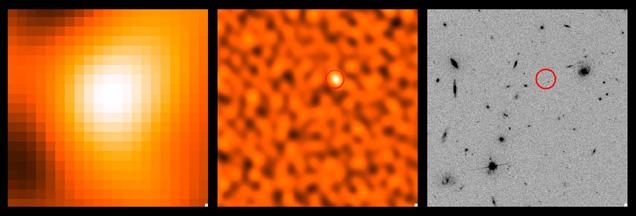
The Submillimeter Array (SMA) detects galaxies in the early universe. The left frame shows the best image (rendered in visible colors) of the discovery of one of the galaxies by a conventional submillimeter camera. The center image shows the SMA picture of the region, pinpointing the source (circled). A visible-light image by the Hubble Space Telescope (right) detected nothing in the area of interest. Combined, these and other data show that the source in question is a very luminous but very distant, dusty galaxy that existed when the universe was less than about 3 billion years old.
A billion years or so after the creation of the universe, and about eight billion years before our own sun formed, the universe underwent a period of dramatic star formation. Recently studies of distant galaxies find that for the next three billion years the universe produced new stars at a rate about five times higher than it does today, roughly fourteen billion years after the creation. Astronomers think that this early burst of activity had a major impact on the cosmos, enriching it with the chemicals essential for life, for example, but also enabling the stately spiral galaxies like our Milky Way to evolve
and eventually nurture a later generation of stars like the sun. After
another few billion years, as the universe continued to age, the frenetic activity declined to what we see today: just a few new stars per year appearing in our galaxy, and corresponding numbers elsewhere. The reasons for the intense star formation in the early universe, and then for the decreased activity, are not well understood, but since these events shaped our own environment, scientists are busy trying to figure out what happened, and why.
A team of seven SAO astronomers led by graduate student Josh Younger, together with seventeen of their colleagues, has used the Submillimeter Array (SMA) in Hawaii to study seven ultraluminous galaxies so distant that their light was emitted only about three billion years after the big bang. These galaxies, like other very luminous galaxies, are as much as one thousand times more energetic than the Milky Way, but they are usually not very bright in visible light. Most of their energy lies in the infrared and submillimeter wavelengths where their thick clouds of dust emit, powered by hyperactive bursts of star formation.
A persistent problem in studying these galaxies is their very small size in the sky (the result of their being at great distances) compounded by the mediocre spatial resolution of the conventional millimeter telescopes that discover them.
Astronomers are therefore hard-pressed to determine if a bright millimeter source coincides with a star, nebula, visible galaxy ... or something else. The superb angular resolution of the SMA enabled it to obtain precise images of the seven galaxies and to conclude that in most cases no known, visible object corresponds to the source. Using complementary data from the Infrared Array Camera (IRAC) on the Spitzer Space Telescope, which was able to see every galaxy, (the IRAC team is led by SAO astronomer Giovanni Fazio), and using other data, the team argues that these seven galaxies are most likely among the youngest ones known in the cosmos, and that they are being powered by star formation. The results will help astronomers model more accurately what was happening when the young universe began to develop its current properties.